ECON08005 - Global Macroeconomic Policies: Fiscal vs Monetary Policy
VerifiedAdded on 2023/06/18
|10
|2666
|257
Essay
AI Summary
This essay provides an analysis of global macroeconomic policies, focusing on the implementation of monetary and fiscal policies and their impact on Gross Domestic Product (GDP) and price levels. It explains how monetary policy, managed by central banks, influences money supply and interest rates to achieve economic stability, while fiscal policy, administered by governments, utilizes revenue collection and expenditure to impact economic growth. The essay discusses expansionary and contractionary approaches for both policies and examines the role of fiscal policy in the UK, particularly in response to the COVID-19 pandemic. It concludes that macroeconomic policies are crucial for stabilizing the economic cycle, controlling inflation, and promoting employment and improved living standards.
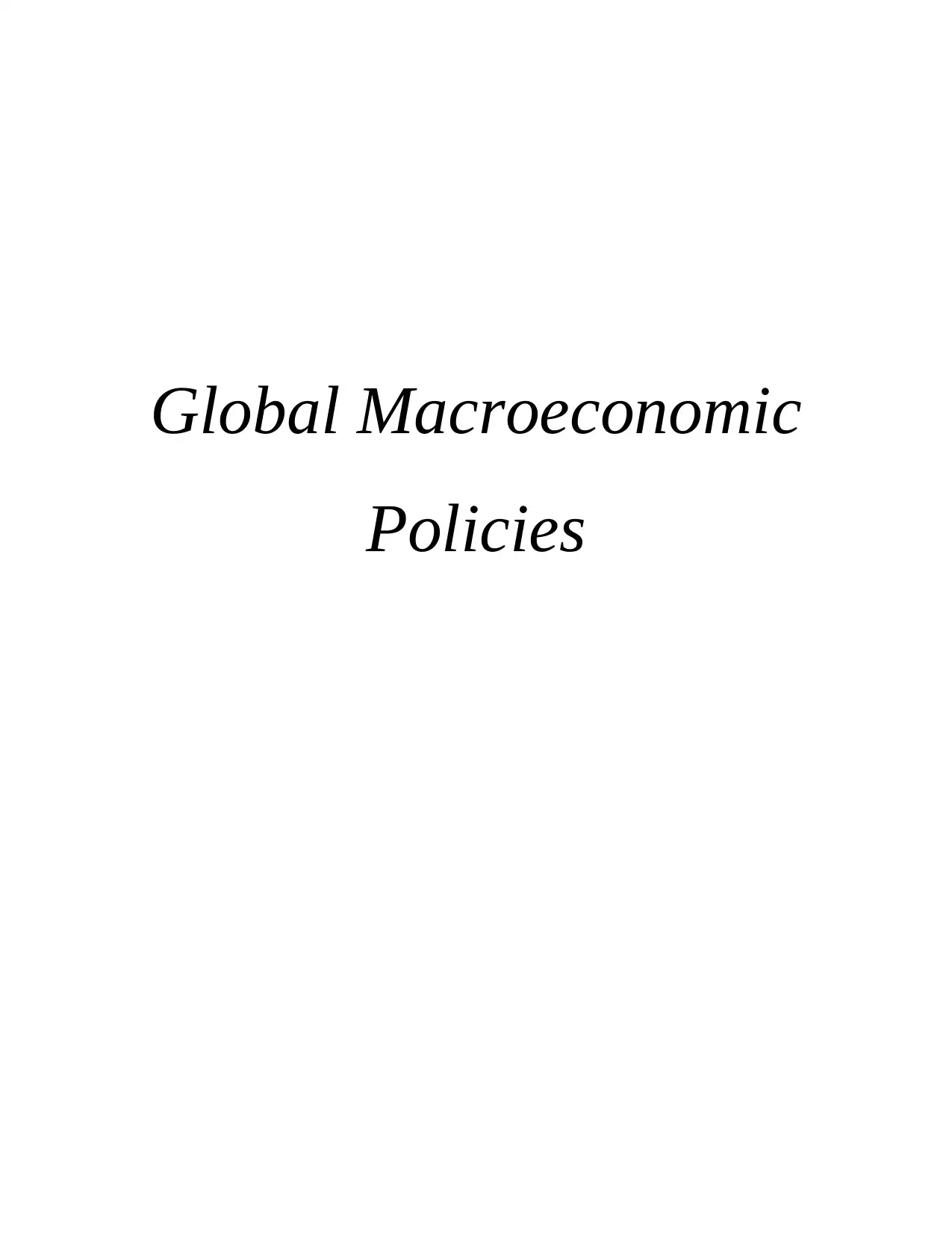
Global Macroeconomic
Policies
Policies
Paraphrase This Document
Need a fresh take? Get an instant paraphrase of this document with our AI Paraphraser
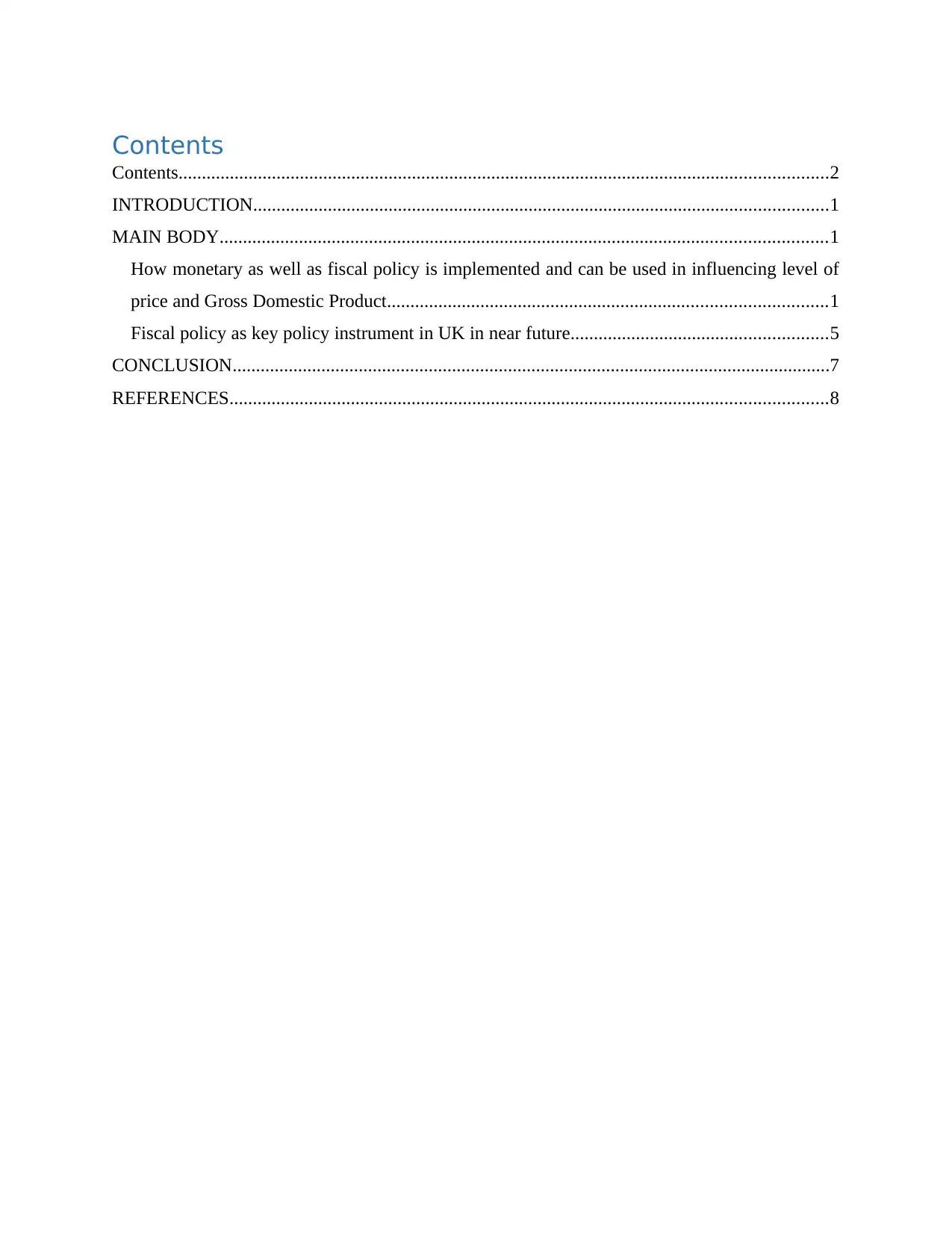
Contents
Contents...........................................................................................................................................2
INTRODUCTION...........................................................................................................................1
MAIN BODY..................................................................................................................................1
How monetary as well as fiscal policy is implemented and can be used in influencing level of
price and Gross Domestic Product..............................................................................................1
Fiscal policy as key policy instrument in UK in near future.......................................................5
CONCLUSION................................................................................................................................7
REFERENCES................................................................................................................................8
Contents...........................................................................................................................................2
INTRODUCTION...........................................................................................................................1
MAIN BODY..................................................................................................................................1
How monetary as well as fiscal policy is implemented and can be used in influencing level of
price and Gross Domestic Product..............................................................................................1
Fiscal policy as key policy instrument in UK in near future.......................................................5
CONCLUSION................................................................................................................................7
REFERENCES................................................................................................................................8

INTRODUCTION
International macroeconomics could be described to study of interactions of economies
among countries. It deals with global aspects related to macroeconomic policy addition to
balance cycle (Han, Qi and Yin, 2016). Macroeconomic policy contributes in rebalancing of
growth and emphasises on analysing decisions that are made by countries along with
governments. It assists in understanding about functioning of complicates economic system and
defines the ways in which economy as whole function along with level of national income is
determined as per aggregate demand and supply. There are two pillars of the policy that are
named as fiscal policy and monetary policy. The assessment explains implementation of
monetary and fiscal policy addition to usage for influencing GDP and level of prices. It further
defines whether fiscal policy will remain key instrument in near future in the countries.
MAIN BODY
How monetary as well as fiscal policy is implemented and can be used in influencing level of
price and Gross Domestic Product
In an economy, macroeconomic policy emphasises towards limiting impacts of business
cycle for attaining economic goals comprising full employment, growth along with price stability
(Weale and Et. Al., 2015). One of the pillar of macroeconomic policy is monetary policy that is
modification of money supply that is printing more money addition to decreasing supply of
money through changing interest rates as well as removing excess reserves. Key purpose of the
policy is to make contribution to stability of gross domestic product so to maintain low
unemployment together with maintain predictable rates of exchange with other currencies. It is
implemented by central banks by controlling supply of money via multiple mechanisms. For
instance, monetary policy in UK is implemented and managed by Bank of England who have
Monetary Policy Committee to make decision for it. With implementation of the instrument,
objectives achieved are promoting maximum employment, moderate interest rates in long term
and stable prices. Major instruments of monetary policy are discount rate, requirements of
reserves and open market operations.
Monetary policy effects on available quantity of loanable funds along with interest rates
that impacts on several components associated to aggregate demand (Loewald, Faulkner and
Makrelov, 2019). contractionary or tight monetary policy causes higher interest rates addition to
1
International macroeconomics could be described to study of interactions of economies
among countries. It deals with global aspects related to macroeconomic policy addition to
balance cycle (Han, Qi and Yin, 2016). Macroeconomic policy contributes in rebalancing of
growth and emphasises on analysing decisions that are made by countries along with
governments. It assists in understanding about functioning of complicates economic system and
defines the ways in which economy as whole function along with level of national income is
determined as per aggregate demand and supply. There are two pillars of the policy that are
named as fiscal policy and monetary policy. The assessment explains implementation of
monetary and fiscal policy addition to usage for influencing GDP and level of prices. It further
defines whether fiscal policy will remain key instrument in near future in the countries.
MAIN BODY
How monetary as well as fiscal policy is implemented and can be used in influencing level of
price and Gross Domestic Product
In an economy, macroeconomic policy emphasises towards limiting impacts of business
cycle for attaining economic goals comprising full employment, growth along with price stability
(Weale and Et. Al., 2015). One of the pillar of macroeconomic policy is monetary policy that is
modification of money supply that is printing more money addition to decreasing supply of
money through changing interest rates as well as removing excess reserves. Key purpose of the
policy is to make contribution to stability of gross domestic product so to maintain low
unemployment together with maintain predictable rates of exchange with other currencies. It is
implemented by central banks by controlling supply of money via multiple mechanisms. For
instance, monetary policy in UK is implemented and managed by Bank of England who have
Monetary Policy Committee to make decision for it. With implementation of the instrument,
objectives achieved are promoting maximum employment, moderate interest rates in long term
and stable prices. Major instruments of monetary policy are discount rate, requirements of
reserves and open market operations.
Monetary policy effects on available quantity of loanable funds along with interest rates
that impacts on several components associated to aggregate demand (Loewald, Faulkner and
Makrelov, 2019). contractionary or tight monetary policy causes higher interest rates addition to
1
⊘ This is a preview!⊘
Do you want full access?
Subscribe today to unlock all pages.

Trusted by 1+ million students worldwide
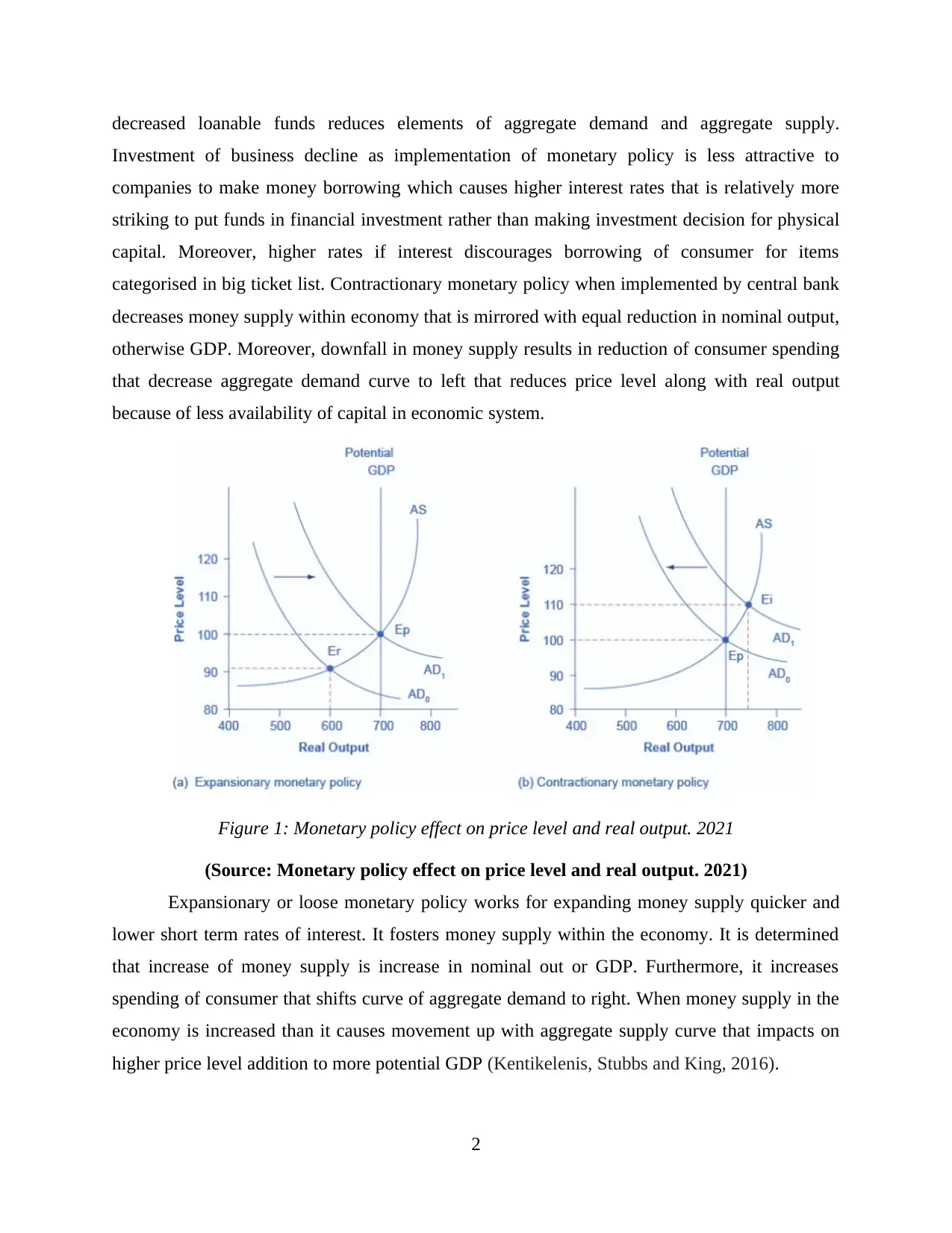
decreased loanable funds reduces elements of aggregate demand and aggregate supply.
Investment of business decline as implementation of monetary policy is less attractive to
companies to make money borrowing which causes higher interest rates that is relatively more
striking to put funds in financial investment rather than making investment decision for physical
capital. Moreover, higher rates if interest discourages borrowing of consumer for items
categorised in big ticket list. Contractionary monetary policy when implemented by central bank
decreases money supply within economy that is mirrored with equal reduction in nominal output,
otherwise GDP. Moreover, downfall in money supply results in reduction of consumer spending
that decrease aggregate demand curve to left that reduces price level along with real output
because of less availability of capital in economic system.
Figure 1: Monetary policy effect on price level and real output. 2021
(Source: Monetary policy effect on price level and real output. 2021)
Expansionary or loose monetary policy works for expanding money supply quicker and
lower short term rates of interest. It fosters money supply within the economy. It is determined
that increase of money supply is increase in nominal out or GDP. Furthermore, it increases
spending of consumer that shifts curve of aggregate demand to right. When money supply in the
economy is increased than it causes movement up with aggregate supply curve that impacts on
higher price level addition to more potential GDP (Kentikelenis, Stubbs and King, 2016).
2
Investment of business decline as implementation of monetary policy is less attractive to
companies to make money borrowing which causes higher interest rates that is relatively more
striking to put funds in financial investment rather than making investment decision for physical
capital. Moreover, higher rates if interest discourages borrowing of consumer for items
categorised in big ticket list. Contractionary monetary policy when implemented by central bank
decreases money supply within economy that is mirrored with equal reduction in nominal output,
otherwise GDP. Moreover, downfall in money supply results in reduction of consumer spending
that decrease aggregate demand curve to left that reduces price level along with real output
because of less availability of capital in economic system.
Figure 1: Monetary policy effect on price level and real output. 2021
(Source: Monetary policy effect on price level and real output. 2021)
Expansionary or loose monetary policy works for expanding money supply quicker and
lower short term rates of interest. It fosters money supply within the economy. It is determined
that increase of money supply is increase in nominal out or GDP. Furthermore, it increases
spending of consumer that shifts curve of aggregate demand to right. When money supply in the
economy is increased than it causes movement up with aggregate supply curve that impacts on
higher price level addition to more potential GDP (Kentikelenis, Stubbs and King, 2016).
2
Paraphrase This Document
Need a fresh take? Get an instant paraphrase of this document with our AI Paraphraser
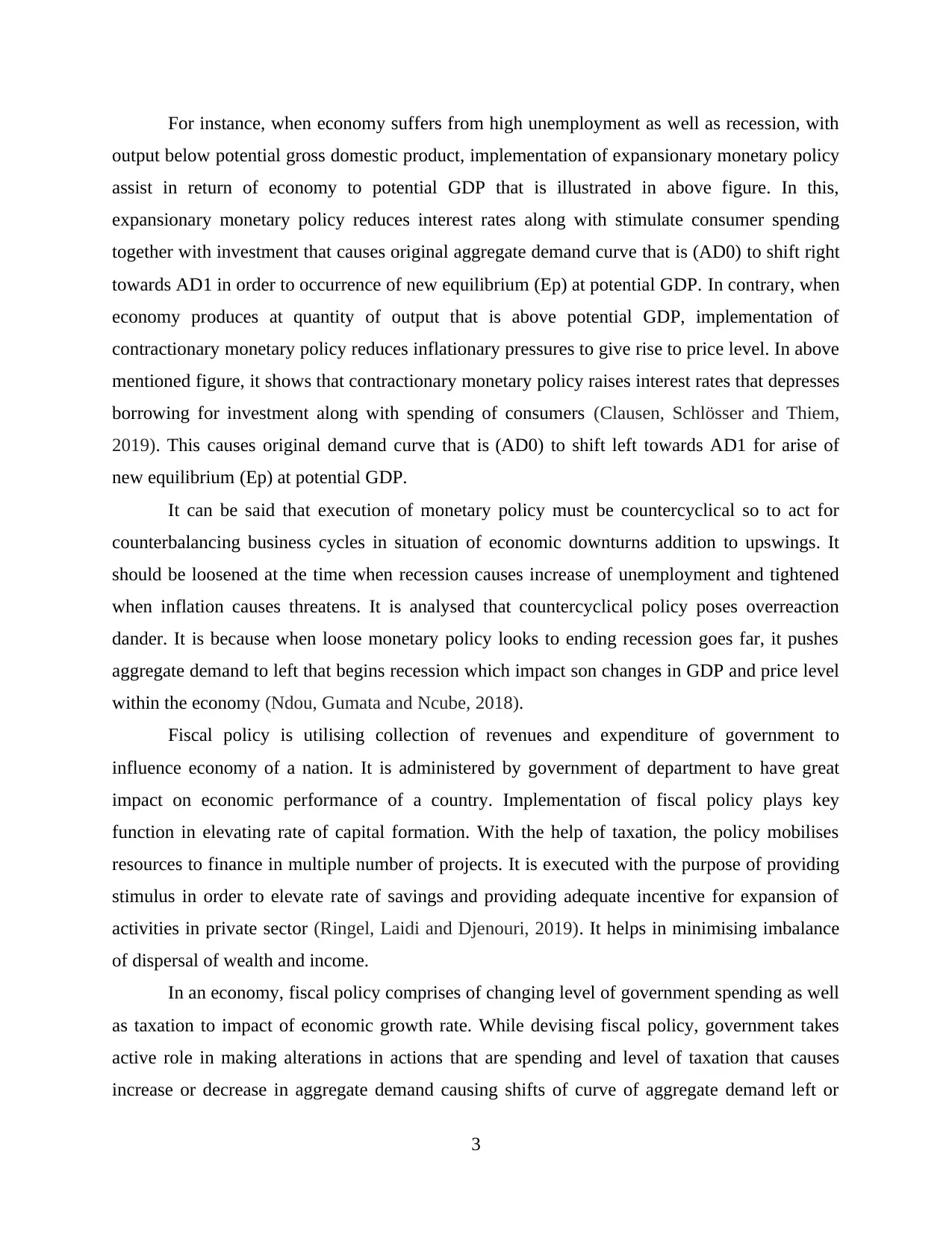
For instance, when economy suffers from high unemployment as well as recession, with
output below potential gross domestic product, implementation of expansionary monetary policy
assist in return of economy to potential GDP that is illustrated in above figure. In this,
expansionary monetary policy reduces interest rates along with stimulate consumer spending
together with investment that causes original aggregate demand curve that is (AD0) to shift right
towards AD1 in order to occurrence of new equilibrium (Ep) at potential GDP. In contrary, when
economy produces at quantity of output that is above potential GDP, implementation of
contractionary monetary policy reduces inflationary pressures to give rise to price level. In above
mentioned figure, it shows that contractionary monetary policy raises interest rates that depresses
borrowing for investment along with spending of consumers (Clausen, Schlösser and Thiem,
2019). This causes original demand curve that is (AD0) to shift left towards AD1 for arise of
new equilibrium (Ep) at potential GDP.
It can be said that execution of monetary policy must be countercyclical so to act for
counterbalancing business cycles in situation of economic downturns addition to upswings. It
should be loosened at the time when recession causes increase of unemployment and tightened
when inflation causes threatens. It is analysed that countercyclical policy poses overreaction
dander. It is because when loose monetary policy looks to ending recession goes far, it pushes
aggregate demand to left that begins recession which impact son changes in GDP and price level
within the economy (Ndou, Gumata and Ncube, 2018).
Fiscal policy is utilising collection of revenues and expenditure of government to
influence economy of a nation. It is administered by government of department to have great
impact on economic performance of a country. Implementation of fiscal policy plays key
function in elevating rate of capital formation. With the help of taxation, the policy mobilises
resources to finance in multiple number of projects. It is executed with the purpose of providing
stimulus in order to elevate rate of savings and providing adequate incentive for expansion of
activities in private sector (Ringel, Laidi and Djenouri, 2019). It helps in minimising imbalance
of dispersal of wealth and income.
In an economy, fiscal policy comprises of changing level of government spending as well
as taxation to impact of economic growth rate. While devising fiscal policy, government takes
active role in making alterations in actions that are spending and level of taxation that causes
increase or decrease in aggregate demand causing shifts of curve of aggregate demand left or
3
output below potential gross domestic product, implementation of expansionary monetary policy
assist in return of economy to potential GDP that is illustrated in above figure. In this,
expansionary monetary policy reduces interest rates along with stimulate consumer spending
together with investment that causes original aggregate demand curve that is (AD0) to shift right
towards AD1 in order to occurrence of new equilibrium (Ep) at potential GDP. In contrary, when
economy produces at quantity of output that is above potential GDP, implementation of
contractionary monetary policy reduces inflationary pressures to give rise to price level. In above
mentioned figure, it shows that contractionary monetary policy raises interest rates that depresses
borrowing for investment along with spending of consumers (Clausen, Schlösser and Thiem,
2019). This causes original demand curve that is (AD0) to shift left towards AD1 for arise of
new equilibrium (Ep) at potential GDP.
It can be said that execution of monetary policy must be countercyclical so to act for
counterbalancing business cycles in situation of economic downturns addition to upswings. It
should be loosened at the time when recession causes increase of unemployment and tightened
when inflation causes threatens. It is analysed that countercyclical policy poses overreaction
dander. It is because when loose monetary policy looks to ending recession goes far, it pushes
aggregate demand to left that begins recession which impact son changes in GDP and price level
within the economy (Ndou, Gumata and Ncube, 2018).
Fiscal policy is utilising collection of revenues and expenditure of government to
influence economy of a nation. It is administered by government of department to have great
impact on economic performance of a country. Implementation of fiscal policy plays key
function in elevating rate of capital formation. With the help of taxation, the policy mobilises
resources to finance in multiple number of projects. It is executed with the purpose of providing
stimulus in order to elevate rate of savings and providing adequate incentive for expansion of
activities in private sector (Ringel, Laidi and Djenouri, 2019). It helps in minimising imbalance
of dispersal of wealth and income.
In an economy, fiscal policy comprises of changing level of government spending as well
as taxation to impact of economic growth rate. While devising fiscal policy, government takes
active role in making alterations in actions that are spending and level of taxation that causes
increase or decrease in aggregate demand causing shifts of curve of aggregate demand left or
3
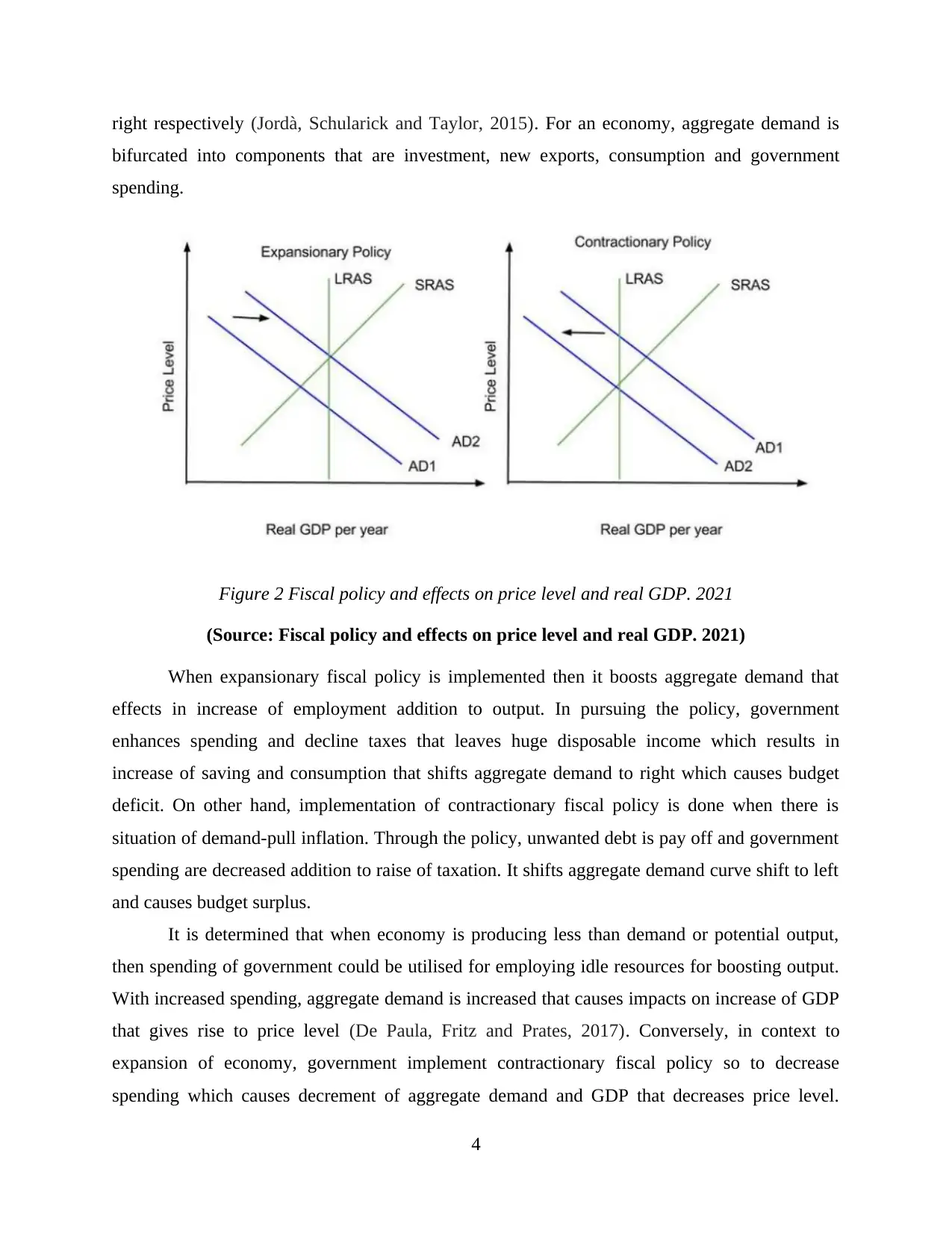
right respectively (Jordà, Schularick and Taylor, 2015). For an economy, aggregate demand is
bifurcated into components that are investment, new exports, consumption and government
spending.
Figure 2 Fiscal policy and effects on price level and real GDP. 2021
(Source: Fiscal policy and effects on price level and real GDP. 2021)
When expansionary fiscal policy is implemented then it boosts aggregate demand that
effects in increase of employment addition to output. In pursuing the policy, government
enhances spending and decline taxes that leaves huge disposable income which results in
increase of saving and consumption that shifts aggregate demand to right which causes budget
deficit. On other hand, implementation of contractionary fiscal policy is done when there is
situation of demand-pull inflation. Through the policy, unwanted debt is pay off and government
spending are decreased addition to raise of taxation. It shifts aggregate demand curve shift to left
and causes budget surplus.
It is determined that when economy is producing less than demand or potential output,
then spending of government could be utilised for employing idle resources for boosting output.
With increased spending, aggregate demand is increased that causes impacts on increase of GDP
that gives rise to price level (De Paula, Fritz and Prates, 2017). Conversely, in context to
expansion of economy, government implement contractionary fiscal policy so to decrease
spending which causes decrement of aggregate demand and GDP that decreases price level.
4
bifurcated into components that are investment, new exports, consumption and government
spending.
Figure 2 Fiscal policy and effects on price level and real GDP. 2021
(Source: Fiscal policy and effects on price level and real GDP. 2021)
When expansionary fiscal policy is implemented then it boosts aggregate demand that
effects in increase of employment addition to output. In pursuing the policy, government
enhances spending and decline taxes that leaves huge disposable income which results in
increase of saving and consumption that shifts aggregate demand to right which causes budget
deficit. On other hand, implementation of contractionary fiscal policy is done when there is
situation of demand-pull inflation. Through the policy, unwanted debt is pay off and government
spending are decreased addition to raise of taxation. It shifts aggregate demand curve shift to left
and causes budget surplus.
It is determined that when economy is producing less than demand or potential output,
then spending of government could be utilised for employing idle resources for boosting output.
With increased spending, aggregate demand is increased that causes impacts on increase of GDP
that gives rise to price level (De Paula, Fritz and Prates, 2017). Conversely, in context to
expansion of economy, government implement contractionary fiscal policy so to decrease
spending which causes decrement of aggregate demand and GDP that decreases price level.
4
⊘ This is a preview!⊘
Do you want full access?
Subscribe today to unlock all pages.

Trusted by 1+ million students worldwide

Moreover, effects of fiscal policy implementation are limited through crowdfunding out that
arises in case when government spending replaces output of private sector despite of adding
some additional output to economy. It raises rate of interest causing limits of investment.
Fiscal policy as key policy instrument in UK in near future
In situation of crisis in UK, fiscal policy played huge role to respond to the pandemic
situation (Kentikelenis, Stubbs and King, 2016). In aftermath of crisis, government of UK had
huge budget deficit in its peace time history.
According to the above graph, it can be said that that the Borrowing in UK which was 5.9
billion pounds in December 2019 increased to 34.1 billion pounds in December 2020. Therefore,
it can be stated that the overall level of borrowings has increased in the country (Budget 2021:
What is it and when will it happen?, 2021).
5
arises in case when government spending replaces output of private sector despite of adding
some additional output to economy. It raises rate of interest causing limits of investment.
Fiscal policy as key policy instrument in UK in near future
In situation of crisis in UK, fiscal policy played huge role to respond to the pandemic
situation (Kentikelenis, Stubbs and King, 2016). In aftermath of crisis, government of UK had
huge budget deficit in its peace time history.
According to the above graph, it can be said that that the Borrowing in UK which was 5.9
billion pounds in December 2019 increased to 34.1 billion pounds in December 2020. Therefore,
it can be stated that the overall level of borrowings has increased in the country (Budget 2021:
What is it and when will it happen?, 2021).
5
Paraphrase This Document
Need a fresh take? Get an instant paraphrase of this document with our AI Paraphraser

Due to the impact created by the 2020 pandemic, the monetary policy of UK was affected
(Kohlscheen, Mojon and Rees, 2020). This was so because it was an unprecedented crisis and
thus it affected the way in which country makes the use of its various types of monetary
resources in a proper manner effectively and efficiently. Therefore, the options which are
available for the country in such a time are as follows-
Controlling the spending- The control on the spending can be kept so that the monetary
resources can be used in a proper way. Therefore, it can be stated that the UK
Government can consider this so that it is able to manage the funds in a right way
effectively and efficiently.
Finding other sources for receipts- It is also important that the other sources for
receipts are found which can be quite helpful in taking the right steps for the purpose of
proper management of the different types of funds in a proper manner. Therefore, the
Government of UK has to make sure that it finds out other sources for receipts which can
help it a lot (Nieto and Et. Al., 2020).
Use of Macroeconomic levers- The macroeconomic levers are required to be adjusted in such a
way so that the crisis which has been created due to the influence of COVID-19 pandemic can be
managed in a right way. This will help the UK economy to recover fast from the impact of the
pandemic.
Constraint in Monetary policy- The constraint in Monetary policy has been there due to
the fact that a proper flow of funds is not taking place within the country. This is creating an
impact on the country. Therefore, it can be stated that this is affecting the UK economy quite
badly.
Relaxation of constraint- Through ensuring the use of reserves, the relaxation of constraint
can be ensured within the country. This will allow to make the use of the various types of funds
in a proper manner. Therefore, in this way this will help the UK economy to be able to function
properly.
Alteration in fiscal policy- There is a need to support economic recovery for the purpose of
properly boosting the economy. Therefore, it is quite important that the fiscal policy should be
altered by ensuring that there is a proper balance between the receipts and payments. Also, it is
necessary to keep the Fiscal Deficit within the set limit so that the management of the particular
level of needs and requirements can be done quite effectively and efficiently (Han, Qi and Yin,
6
(Kohlscheen, Mojon and Rees, 2020). This was so because it was an unprecedented crisis and
thus it affected the way in which country makes the use of its various types of monetary
resources in a proper manner effectively and efficiently. Therefore, the options which are
available for the country in such a time are as follows-
Controlling the spending- The control on the spending can be kept so that the monetary
resources can be used in a proper way. Therefore, it can be stated that the UK
Government can consider this so that it is able to manage the funds in a right way
effectively and efficiently.
Finding other sources for receipts- It is also important that the other sources for
receipts are found which can be quite helpful in taking the right steps for the purpose of
proper management of the different types of funds in a proper manner. Therefore, the
Government of UK has to make sure that it finds out other sources for receipts which can
help it a lot (Nieto and Et. Al., 2020).
Use of Macroeconomic levers- The macroeconomic levers are required to be adjusted in such a
way so that the crisis which has been created due to the influence of COVID-19 pandemic can be
managed in a right way. This will help the UK economy to recover fast from the impact of the
pandemic.
Constraint in Monetary policy- The constraint in Monetary policy has been there due to
the fact that a proper flow of funds is not taking place within the country. This is creating an
impact on the country. Therefore, it can be stated that this is affecting the UK economy quite
badly.
Relaxation of constraint- Through ensuring the use of reserves, the relaxation of constraint
can be ensured within the country. This will allow to make the use of the various types of funds
in a proper manner. Therefore, in this way this will help the UK economy to be able to function
properly.
Alteration in fiscal policy- There is a need to support economic recovery for the purpose of
properly boosting the economy. Therefore, it is quite important that the fiscal policy should be
altered by ensuring that there is a proper balance between the receipts and payments. Also, it is
necessary to keep the Fiscal Deficit within the set limit so that the management of the particular
level of needs and requirements can be done quite effectively and efficiently (Han, Qi and Yin,
6
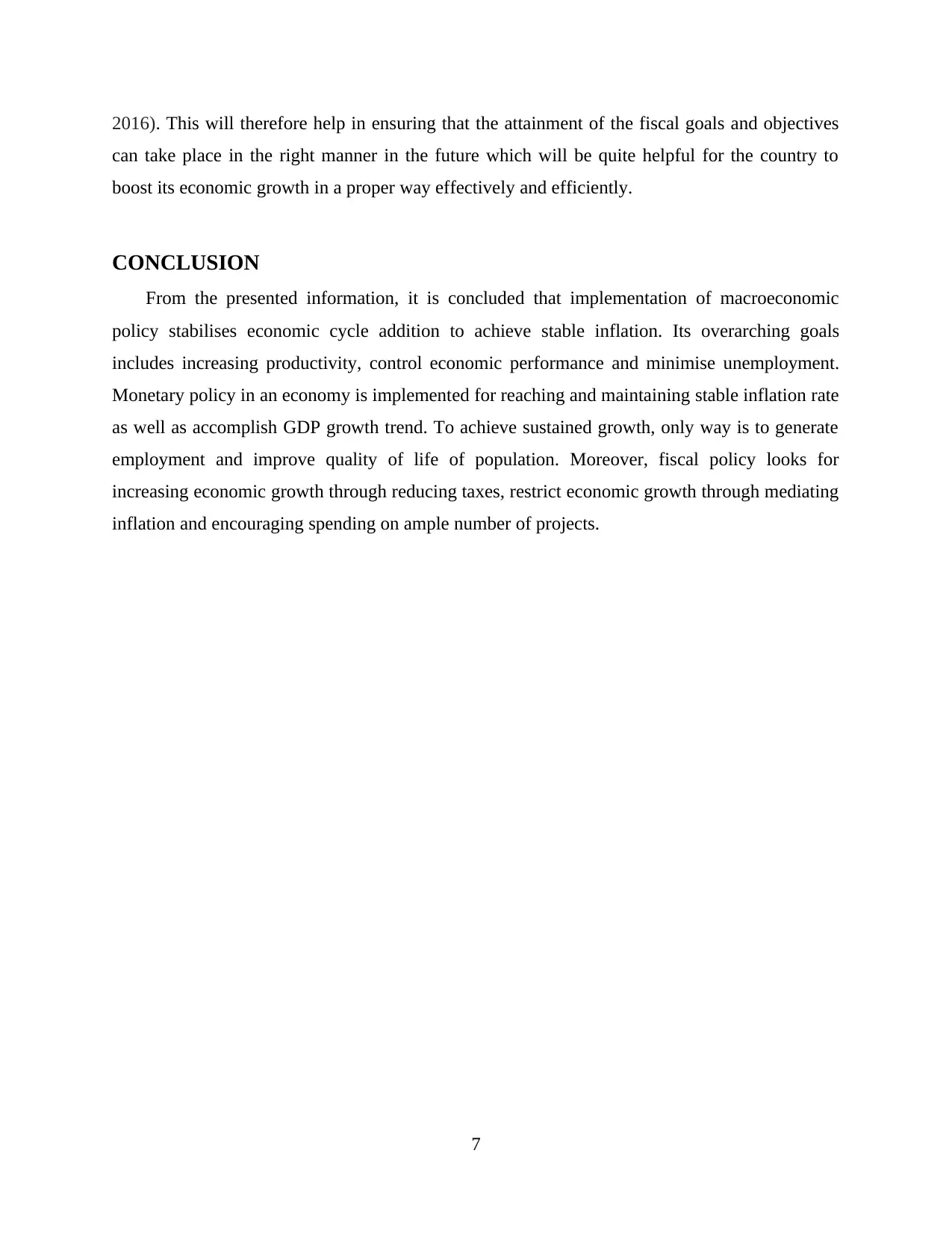
2016). This will therefore help in ensuring that the attainment of the fiscal goals and objectives
can take place in the right manner in the future which will be quite helpful for the country to
boost its economic growth in a proper way effectively and efficiently.
CONCLUSION
From the presented information, it is concluded that implementation of macroeconomic
policy stabilises economic cycle addition to achieve stable inflation. Its overarching goals
includes increasing productivity, control economic performance and minimise unemployment.
Monetary policy in an economy is implemented for reaching and maintaining stable inflation rate
as well as accomplish GDP growth trend. To achieve sustained growth, only way is to generate
employment and improve quality of life of population. Moreover, fiscal policy looks for
increasing economic growth through reducing taxes, restrict economic growth through mediating
inflation and encouraging spending on ample number of projects.
7
can take place in the right manner in the future which will be quite helpful for the country to
boost its economic growth in a proper way effectively and efficiently.
CONCLUSION
From the presented information, it is concluded that implementation of macroeconomic
policy stabilises economic cycle addition to achieve stable inflation. Its overarching goals
includes increasing productivity, control economic performance and minimise unemployment.
Monetary policy in an economy is implemented for reaching and maintaining stable inflation rate
as well as accomplish GDP growth trend. To achieve sustained growth, only way is to generate
employment and improve quality of life of population. Moreover, fiscal policy looks for
increasing economic growth through reducing taxes, restrict economic growth through mediating
inflation and encouraging spending on ample number of projects.
7
⊘ This is a preview!⊘
Do you want full access?
Subscribe today to unlock all pages.

Trusted by 1+ million students worldwide

REFERENCES
Books and Journals:
Clausen, V., Schlösser, A. and Thiem, C., 2019. Economic policy uncertainty in the euro area:
cross-country spillovers and macroeconomic impact. Jahrbücher für Nationalökonomie
und Statistik. 239(5-6). pp.957-981.
De Paula, L. F., Fritz, B. and Prates, D. M., 2017. Keynes at the periphery: Currency hierarchy
and challenges for economic policy in emerging economies. Journal of Post Keynesian
Economics. 40(2). pp.183-202.
Han, L., Qi, M. and Yin, L., 2016. Macroeconomic policy uncertainty shocks on the Chinese
economy: a GVAR analysis. Applied Economic. 48(51). pp.4907-4921.
Jordà, Ò., Schularick, M. and Taylor, A. M., 2015. Betting the house. Journal of International
Economics. 96. pp.S2-S18.
Kentikelenis, A. E., Stubbs, T. H. and King, L. P., 2016. IMF conditionality and development
policy space, 1985–2014. Review of International Political Economy. 23(4). pp.543-
582.
Kohlscheen, E., Mojon, B. and Rees, D., 2020. The macroeconomic spillover effects of the
pandemic on the global economy. Available at SSRN 3569554.
Loewald, C., Faulkner, D. and Makrelov, K., 2019. Macroeconomic Policy Options for a
Savings Constrained Economy: The Case of South Africa. Journal of Development
Perspectives. 3(1-2). pp.220-241.
Ndou, E., Gumata, N. and Ncube, M., 2018. Global economic uncertainties and exchange rate
shocks: Transmission channels to the South African economy. Springer.
Nieto, J. and Et. Al., 2020. Macroeconomic modelling under energy constraints: Global low
carbon transition scenarios. Energy Policy. 137. p.111090.
Ringel, M., Laidi, R. and Djenouri, D., 2019. Multiple benefits through smart home energy
management solutions—A simulation-based case study of a single-family-house in
algeria and Germany. Energies. 12(8). p.1537.
Weale, M. and Et. Al., 2015. Macroeconomic policy: inflation, wealth and the exchange rate.
Routledge.
Online
Budget 2021: What is it and when will it happen?. 2021. [Online]. Available through:
<https://www.bbc.com/news/business-55765868>
8
Books and Journals:
Clausen, V., Schlösser, A. and Thiem, C., 2019. Economic policy uncertainty in the euro area:
cross-country spillovers and macroeconomic impact. Jahrbücher für Nationalökonomie
und Statistik. 239(5-6). pp.957-981.
De Paula, L. F., Fritz, B. and Prates, D. M., 2017. Keynes at the periphery: Currency hierarchy
and challenges for economic policy in emerging economies. Journal of Post Keynesian
Economics. 40(2). pp.183-202.
Han, L., Qi, M. and Yin, L., 2016. Macroeconomic policy uncertainty shocks on the Chinese
economy: a GVAR analysis. Applied Economic. 48(51). pp.4907-4921.
Jordà, Ò., Schularick, M. and Taylor, A. M., 2015. Betting the house. Journal of International
Economics. 96. pp.S2-S18.
Kentikelenis, A. E., Stubbs, T. H. and King, L. P., 2016. IMF conditionality and development
policy space, 1985–2014. Review of International Political Economy. 23(4). pp.543-
582.
Kohlscheen, E., Mojon, B. and Rees, D., 2020. The macroeconomic spillover effects of the
pandemic on the global economy. Available at SSRN 3569554.
Loewald, C., Faulkner, D. and Makrelov, K., 2019. Macroeconomic Policy Options for a
Savings Constrained Economy: The Case of South Africa. Journal of Development
Perspectives. 3(1-2). pp.220-241.
Ndou, E., Gumata, N. and Ncube, M., 2018. Global economic uncertainties and exchange rate
shocks: Transmission channels to the South African economy. Springer.
Nieto, J. and Et. Al., 2020. Macroeconomic modelling under energy constraints: Global low
carbon transition scenarios. Energy Policy. 137. p.111090.
Ringel, M., Laidi, R. and Djenouri, D., 2019. Multiple benefits through smart home energy
management solutions—A simulation-based case study of a single-family-house in
algeria and Germany. Energies. 12(8). p.1537.
Weale, M. and Et. Al., 2015. Macroeconomic policy: inflation, wealth and the exchange rate.
Routledge.
Online
Budget 2021: What is it and when will it happen?. 2021. [Online]. Available through:
<https://www.bbc.com/news/business-55765868>
8
1 out of 10
Related Documents
Your All-in-One AI-Powered Toolkit for Academic Success.
+13062052269
info@desklib.com
Available 24*7 on WhatsApp / Email
![[object Object]](/_next/static/media/star-bottom.7253800d.svg)
Unlock your academic potential
Copyright © 2020–2025 A2Z Services. All Rights Reserved. Developed and managed by ZUCOL.





